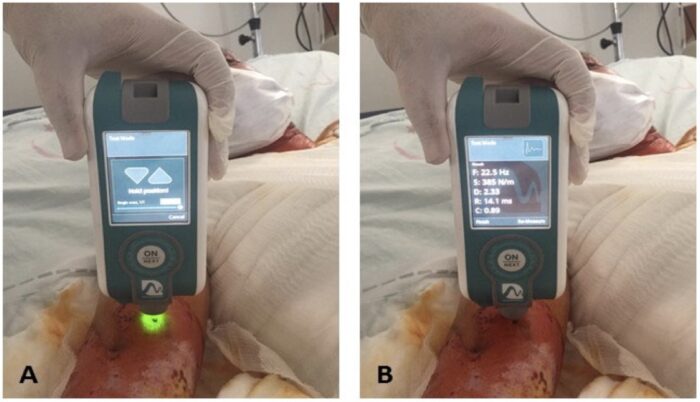Publications

An Investigation of Muscle Mechanical Properties in Acute Burns and Burn Types
Authors: Engin Ramazanoglu 1, Serkan Usgu 2, Yavuz Yakut 2, Murat Ali Cinar 2, Kezban Bayramlar 2, Ali Gunes 3, Ahmet Erkilic 3
Affiliations:
- Physiotherapy and Rehabilitation Department, Faculty of Health Sciences, SANKO University, 27000 Gaziantep, Turkey
- Physiotherapy and Rehabilitation Department, Faculty of Health Science, Hasan Kalyoncu University, 27000 Gaziantep, Turkey
- General Surgery, Burn Center, Gaziantep City Hospital, 27000 Gaziantep, Turkey
Journal: Journal of Clinical Medicine - March 2025, Volume 14, Issue 7, Article no. 2344 (DOI: 10.3390/jcm14072344)
-
Field & Applications:
- Medical
- Progression monitoring
- Recovery from injury
- Musculoskeletal rehabilitation
Objectives: This study investigated the mechanical properties (tone, stiffness, and elasticity) of the biceps brachii (BB) muscle in the acute phase of different burn types.
Methods: A total of 30 individuals (18–63 years) participated and were divided into three groups: flame, electrical, and scald burns. Myotonometric measurements assessed BB muscle tone, stiffness, and elasticity at admission (week 1) and at weeks 2 and 3.
Results: When comparing the three time points, BB tone and stiffness significantly decreased by week 3 (p < 0.05), while elasticity remained unchanged (p > 0.05). Across burn types, BB tone, stiffness, and elasticity were similar at all three time points (p > 0.05). In the acute phase, BB tone and stiffness decreased by week 3, but elasticity showed no change.
Conclusions: Different burn types exhibited similar BB mechanical properties over time. However, burn types may influence muscle tone and stiffness differently during acute recovery. Further studies with larger populations are needed to compare treatments across burn types and assess long-term mechanical property changes.

Figure 2. (A). Prior to the myotonometric measurement of the biceps brachii muscle, (B). The measurement result obtained from the reference point.
Keywords: burn, biceps brachii, tone, stiffness, elasticity
This study investigated the mechanical properties (tone, stiffness, and elasticity) of the biceps brachii (BB) muscle in different types of burns during the acute phase. Our findings indicate that BB tone and stiffness significantly decreased by the third week, while elasticity remained unchanged. Interestingly, the mechanical properties did not show statistically significant differences between burn types (flame, electrical, and scald burns) at any of the three time points. However, burn types exhibited different recovery characteristics, especially in terms of muscle tone and stiffness. Among the burn types, electrical burns showed a more pronounced increase in creatine kinase (CK) levels in the first week, which later decreased and became similar to other burn types in the third week. This suggests that electrical burns cause extensive muscle damage initially, but tissue repair mechanisms become more active over time. Our results suggest that muscle mechanical properties are influenced not only by the burn type but also by systemic responses, including neural, metabolic, and vascular changes. The reduction in muscle stiffness and tone observed in the third week may be related to collagen remodeling, metabolic shifts, and neurophysiological adaptations. Despite the absence of statistically significant differences in mechanical properties between burn types, electrical burns appear to have unique characteristics related to muscle physiology, likely due to vascular compromise, altered nerve conduction, and tissue necrosis.
Clinical Implications: Our study highlights the potential use of myotonometric measurements as an objective, non-invasive, and rapid method for assessing muscle mechanical properties in burn patients. These measurements could be useful for the following areas: Monitoring recovery progress and guiding rehabilitation interventions. Differentiating between burn types and estimating tissue damage severity. Providing insights into the neuromuscular adaptations following burn injuries. In conclusion, this study provides a novel perspective on muscle mechanical properties in acute burns, emphasizing the need for larger, long-term studies to better understand the complex physiological changes occurring in burn patients.


